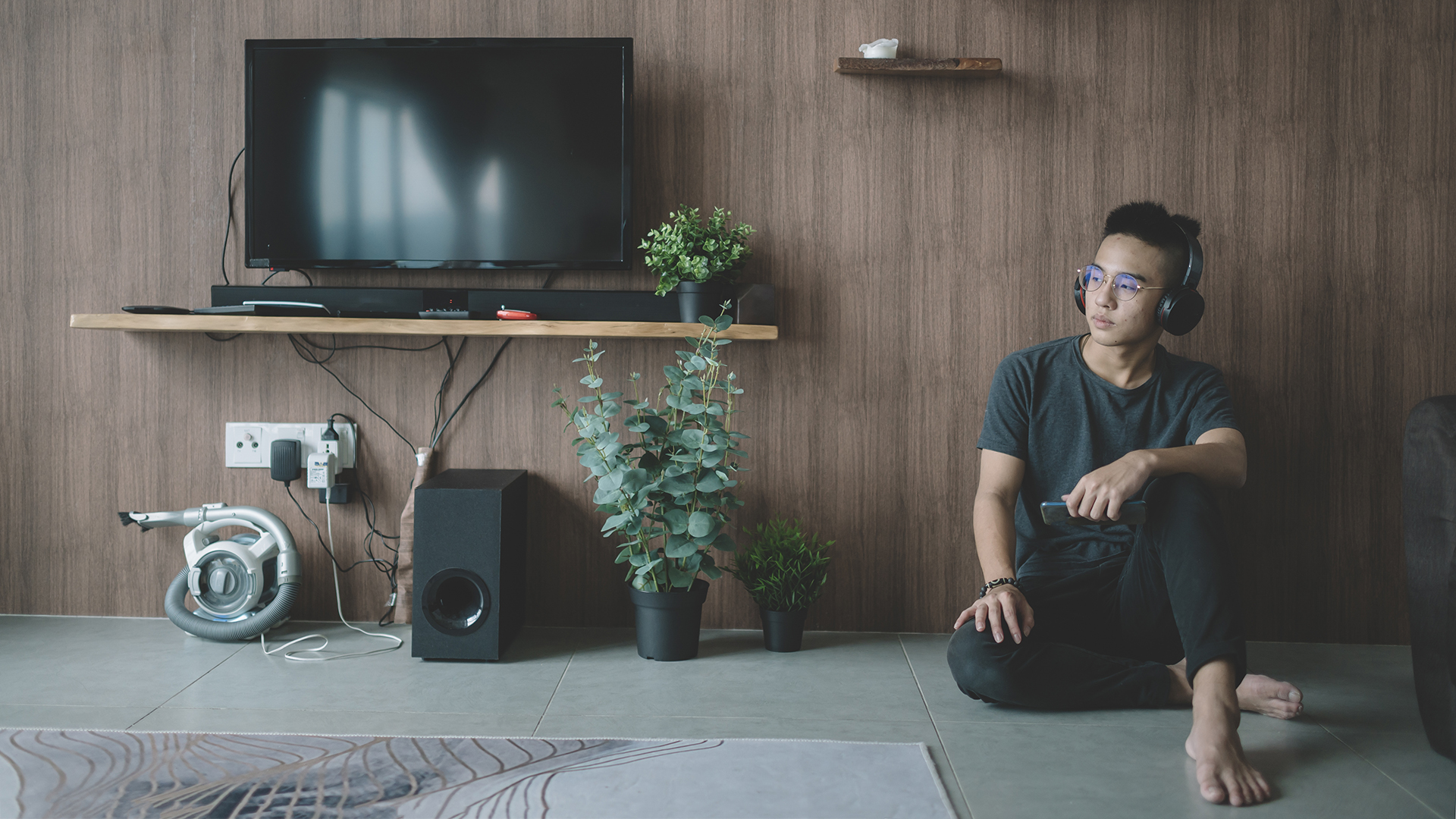What is Dolby Atmos? (And does your home theater need it?)
What is Dolby Atmos? Well, it's one of the best ways to elevate your movie-viewing experience at home.

If you want to know what is Dolby Atmos, the likelihood is that you're already curious about getting the best audio setup you possibly can for your headphones and speakers. Essentially, Dolby Atmos is a ground-breaking 3D sound platform that can bring panoramic sound to audio devices, making your listening experience more immersive.
When used in conjunction with the best Blu-Ray players and the best soundbars, Dolby Atmos is able to simulate a fully 3D audio environment. This means that dynamic sound can reach your ears from all around you, including from above. Whether you're listening to audio from movies, games or music, this means that you're having an enhanced experience with much more detail than would have previously been possible.
This is just a small insight into what Dolby Atmos is, but we've explored how the system works and whether it's worth investing in below.
What is Dolby Atmos?
"In the traditional surround system, you are surrounded by speakers on a horizontal plane. As an engineer, you can place sound in a direction from those speakers in that plane."
"However, with Dolby Atmos, you have 'overhead' firing speakers, which take that 2D plane and turn it into 3D. So now, instead of simply placing sound in a horizontal direction, an engineer can place sound three-dimensionally anywhere in space. You're taking that canvas from a 2D plane to a 3D plane."
Otto Jørgensen, product training manager, Dynaudio
You might be interested to know that Dolby Atmos isn't actually a new technology. In fact, it was debuted in 2012 with the release of the Pixar movie Brave. It was immediately noted for its ability to create rich soundscapes that drew viewers deeper into the cinematic experience.
Within a few years, Dolby Atmos technology was made available to home theater setups. This disrupted to traditional speaker setup of stereo, 5.1 and 7.1, as new height channels that recreated sounds on the vertical plane were added. This meant that sounds weren't just created at ear-level, they could be transmitted at various different heights for a more immersive experience.
How does Dolby Atmos work?
The vital addition of height channels differentiates a Dolby Atmos home setup from a standard 5.1 or 7.1 surround sound system. To reproduce truly accurate surround sound, Dolby Atmos treats individual sounds as ‘objects’.
These audio objects aren't tethered to fixed points within an environment. Instead, they can move around the space according to the relevant action on screen. For example, if you're watching a movie scene with a helicopter flying, ordinary 5.1 or 7.1 setups would mean that the aircraft could be heard flying from behind you, past you and in front of you.
Sign up to receive the latest news, reviews, buying guides and deals direct to your inbox

However, Dolby Atmos means that the helicopter – or rather the audio object that carries the sound of the helicopter – can rise or fall according to the relative height of the aircraft in relation to you and the Atmos AV receiver. This means that you could hear the helicopter hovering directly above you.
Dolby Atmos gives sound engineers in games, movies and other forms of entertainment incredible freedom to dedicate audio channels to specific objects that can be choreographed within a scene. Distant birdsong and conversations in a crowd, planes flying overhead, and explosions in action-packed sequences… With Dolby Atmos, all such individual elements can be manipulated to build the most immersive, detailed soundscapes.
Is Dolby Atmos good for music?
Many – including Dyaudio's Otto Jørgensen – believe that the 3D nature of Dolby Atmos makes music sound better, as voices and instruments aren't 'fighting to be heard' on the same horizontal plane.
"When engineers are mixing a track, everything is object orientated," Otto explains. "With stereo, they'd say 'this guitar goes in this speaker', or maybe 'partly in this speaker, partly in that speaker', working with each channel of the speakers. But with Dolby Atmos, you're not really considering the speakers – you're placing objects in space. 'I have a 3D space on my computer and I want the guitar to go here, and so I sit the guitar there'. A computer then figures out what speaker or speakers it needs to play that object in, in order for it to be 'heard' in that position. The sound might be coming out of four different speakers, in order to place the sound in the right place in the room."
"Essentially, in stereo you have the limitation that sounds will mask each other. If you have too much stuff overlapping, it becomes a wall of sound and you can't hear that detail. With Dolby Atmos, voices and instruments don't mask each other in the same way. That gives a scale and standard of sound that's a lot better throughout."
How to use Dolby Atmos at home
Now you know what Dolby Atmos is, you’re probably wondering how you can enjoy this audio experience at home. Well the good news is, if you have an existing 5.1 or 7.1 (or more) surround sound system, you can modify your setup to be Dolby Atmos-enabled with just a few additions.
1. Upgrade your existing surround sound with a Dolby-Atmos AVR
The most important piece of equipment is a Dolby Atmos-enabled audio-visual receiver (AVR). With a little configuration, this device will detect how many speakers you have and use an Object Audio Renderer to relay audio objects through the most appropriate speaker.
Like a lot of home theater equipment, Dolby Atmos-enabled AVRs aren’t cheap, but you can pick up good models such as the Onkyo TX-SR494 AV Receiver or the Sony STRDH590 5.2 Channel Surround Sound Home Theater Receiver for about $350.
2. Invest in upward-firing speakers
The next pieces of equipment you’ll need to really get the most out of Dolby Atmos are upward-firing speakers. These speakers ‘bounce’ soundwaves off the ceiling to accurately represent sounds above the listener. Dolby recommends two of these upward-firing speakers in front and two behind the listener. Models such as the Sony SSCSE Dolby Atmos Enabled Speakers cost about $230.
3. Try a Dolby Atmos soundbar
Some of the best soundbars such as the Samsung HW-Q90R are now Dolby Atmos-enabled too, enriching the experience further from wherever you’ve placed it.
4. Love gaming or music? Get a set of Dolby Atmos-compatible headphones
"Dolby Atmos has been designed with headphones in mind," says Otto Jørgensen. "Artists and engineers may be working on speakers when they are designing the sound, but it's being mixed down for playback on headphones, so you're hearing more 3D-like sound. That's what I think will drive Dolby Atmos to become an important sound standard. Headphones are such big business, and if you can improve the sound in headphones through Dolby Atmos, it's going to drive artists to embrace it."
For a pair of headphones that can deliver Dolby Atmos through their Spacial Audio technology, try Apple's AirPods Max headphones, current $449.99 at Amazon.
It may require some investment to experience Dolby Atmos at home for yourself, but if having the best audio is important to you, then it provides arguably the most thrilling and authentic audio experience available right now.
Discover more tech guides
Best DVD players
Best mini projectors
Best Bluetooth headsets
Rich Lee is Tech Editor at Top Ten Reviews and writes about all forms of consumer technology, especially products that make domestic life easier and more fun. When he's not pouring over current affairs, pop culture and the latest developments in tech in his free time, Rich is probably pouring his seventh coffee of the day and pondering where to go out for dinner.
- Louise CareyEditor
- Amy CutmoreEditor In Chief, Homes Audience

